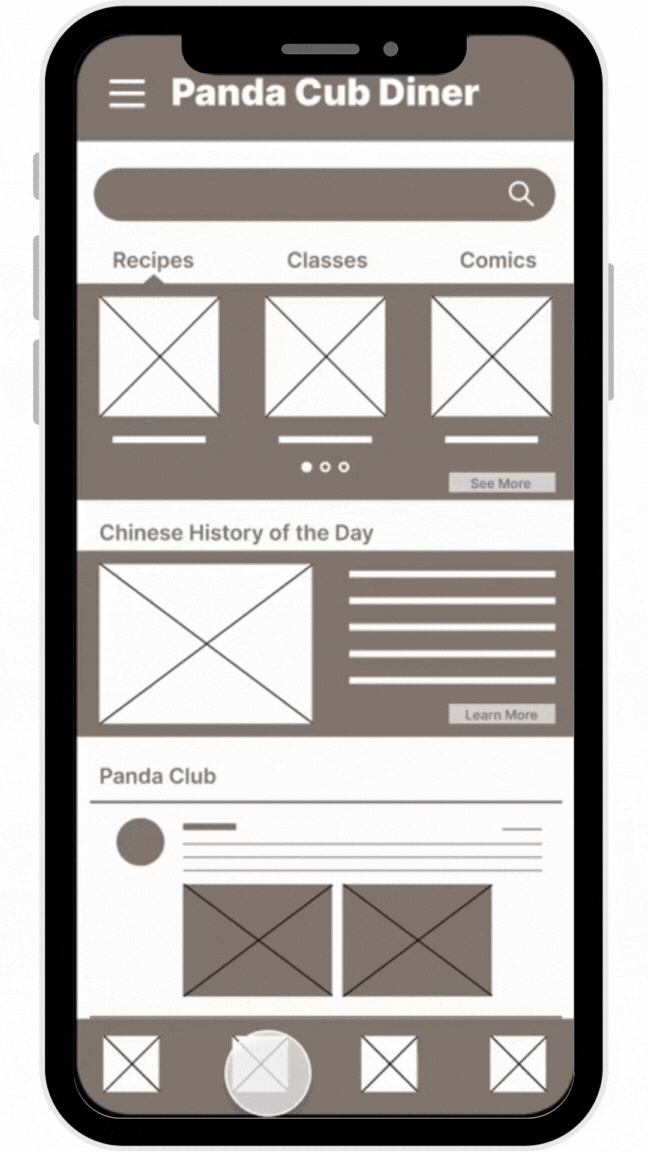top of page
Panda Cub Diner
An all-in-one app that allows users to plan, prepare, and cook authentic Chinese food while learning snippets of culture and connecting with like-minded community members
Context
Product description: Panda Cub Diner is a platform that provides Sichuan food recipes, step-by-step video cooking lessons, and Chinese history and culture lessons. It aims to spread the love for Sichuan food and to connect immigrants and overseas individuals with their Chinese heritage.
My Role
This solo project is part of my ongoing Google Career Certificate program in UX design. I follow the Design Thinking framework (empathize, define, ideate, prototype, and test) to create a high-fidelity prototype.
Time Frame
August, 2025 - present
Skills
User research, prototyping, design system, user testing
Software
Procreate, Canva, Figma, Adobe XD
Work in Progress: Low Fidelity Prototype


Next Step
The next step is to refine the design using the insights from the usability study and to create a high-fidelity prototype on Figma.
Understanding the User
User Personas
Persona 1: Wei
Problem statement: Wei is a Chinese American college student who needs to learn Chinese culture through cooking because he wants to be independent and to connect with his heritage.

Persona 2: Tina
Problem statement: Tina is a data engineer who needs an ADHD-friendly way to learn how to cook Chinese food because she wants to enjoy it with her husband who is a Chinese immigrant.

Goal Statement
Panda Cub Diner will allow users to plan, prepare, and cook Sichuan dishes while learning Chinese history and culture, which will affect users who are interested in learning how to cook Sichuan food with little experience by providing video classes, recipe with checklists, and community posts. I will measure effectiveness by keeping track of lesson purchases and community activities.
User Journey Map
Goal: Find the most time- and energy-efficient way to learn to cook a couple of Sichuan dishes for dinner

Competitor Audit
In order to understand the market and to learn from others about what has and has not worked, I identified both direct and indirect competitors of Panda Cub Diner. I ran a competitor audit to compare and contrast my competitors' offerings, meaning products, services, and features.



Starting the Design
Storyboards


Paper Wireframes
I wanted the home page to highlight some of Panda Cub Diner’s unique features, including snippets of Chinese culture, recipes by categories, video classes, and community posts/testimonies. I prioritized categorized recipes and Chinese culture of the day.

Digital Wireframes
Panda Cub Diner differs from other recipe apps by its emphasis on community and Asian heritage. Therefore, I made sure those elements were easy to spot on the home page. Once the user clicks on one of the recipe categories, they are greeted with recipes of that chosen category. I used Food Network’s layout as reference when designing this page. I added reviews in stars to hone in on the theme of community. After selecting a dish to make, the user enters the recipe page with directions. I prioritized the video lesson. Ingredients and steps all have circular checkboxes to accommodate users with ADHD who might need help tracking their process.

Usability Study and Observation Insight
Usability Study
After the creation of the low-fidelity prototype, I conducted a usability study with 5 users to better understand user pain points and refine the design. During the usability study, I took notes on my observations.

Findings and Affinity Diagram
The usability study allowed me to identify themes and develop actionable insights. I created an affinity diagram to visualize the information. Users' needs were written on Jamborad sticky notes and were grouped by themes.

The Jamboard information was then summarized into statements with action items.

bottom of page